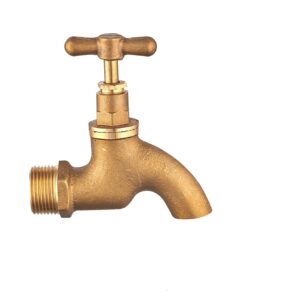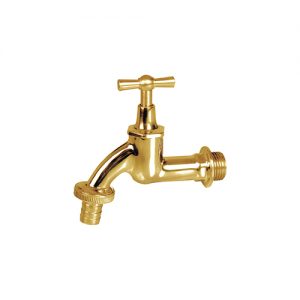Description
Sanitary Washing Valve
JX-0511
- Brass Water Nozzle Tap
- Size 1/2″ X3/4″
- Full brass with handle
- Sandblasted and chrome plated.
- Media; Water; Seawater
- Max pressure;21 bar
- Temperature;0-100℃
- ISO228/1 thread.
This bib cock is an ideal replacement for an outside tap. The body of the angled pattern ball bibcock is chrome-plated brass. The quarter-turn handle is in place of a standard tee handle, making it easier to operate. The spout includes a hose fitting for a standard garden hose.
Function
The bibcock is connected to a water source on one end, and the other is an outlet. The handle on the bibcock controls the flow of water passing through the hose, opening or closing an internal valve to supply water depending on need.
What is a garden tap?
A garden tap is a type of faucet specifically for gardens. It can water plants, wash vegetables, or get water anywhere in the garden! Garden taps are surprisingly versatile, and many different types depend on your need.
There are two main garden taps: the standard tap and the trigger tap. The average fixture is just a regular faucet you would use in your house, except it’s made for outdoor use. It has a long metal spout that quickly reaches plants or areas far away from the water source. The trigger tap is explicitly designed for watering plants. It has a small nozzle on the end that you squeeze to release water, which is much easier than holding onto a standard tap with one hand while you water with the other!
No matter what type of garden tap you choose, be sure to get one made for outdoor use. Standard faucets aren’t meant to withstand weather conditions like rain or snow and can quickly corrode or rust. Garden taps are usually brass or stainless steel, with good weathering resistance.

Functionality: How it Works
Sanitary washing valves are essential to many businesses that handle food and beverages. Understanding how these machines work is necessary for anyone working in this field.
The purpose of a sanitary washing valve is to maintain a clean, hygienic environment by preventing contamination from entering the product stream. This is accomplished by using a combination of mechanical, electrical, and chemical components to automatically regulate the flow of water into the system. The valve opens at regular intervals, allowing water to enter, and then closes once the desired level has been reached.
In addition, sanitary washing valves also help reduce waste by controlling how much water enters into each cycle and how long it takes to release it from the system.
Maintenance Requirements: Clean & Care
Regular maintenance of the Sanitary Washing Valve is essential to ensure it continues functioning properly. Cleaning and caring for the valve will help to prevent the build-up of dirt, debris, and other contaminants that can cause severe damage or system malfunctions. Proper care also extends the valve’s life and helps avoid costly repairs in the future.
To keep your Sanitary Washing Valve in optimal condition, it should be cleaned regularly with a soft brush or cloth and warm water. Pay special attention to areas where corrosion may occur, such as joints or threads, making sure all dirt and grime are removed before lubrication with non-corrosive oil if necessary. It’s essential to check all seals periodically to ensure they are correctly seated, as this could lead to leaks that could damage surrounding components if not addressed immediately.
Installation Process: Steps to Install
Installing a sanitary washing valve can be an easy and cost-effective way to update your kitchen or bathroom. It is important to read instructions carefully before starting the installation process, as improper installation can lead to leaking and other complications. Here are the steps you should take when installing a sanitary washing valve:
First, turn off the water supply and drain residual water from pipes by turning on hot and cold taps. Next, place the new valve in its designated space, using a leveler if necessary, to ensure it is correctly aligned. After connecting all the piping correctly, cover them with insulation material to protect against any possible leaks or corrosion due to temperature changes. Finally, slowly open hot and cold water supplies and check for any signs of leaks or irregularities in pressure before entirely securing all connections with the plumber’s tape.
Benefits of Using Sanitary Valves
Sanitary valves are essential components used in the food and beverage industry for washing, processing, and packaging food items. They help ensure that the hygiene of these products is maintained throughout the process. Valves provide a safe and sanitized environment for workers and consumers.
These valves are designed to prevent contamination by cross-contamination between products or byproducts. Most importantly, they provide a reliable way to separate clean water from contaminated water during manufacturing. This ensures that only uncontaminated ingredients make their way into processed foods, making them safer for consumption.
In addition to greater safety assurance, using sanitary valves can also help reduce costs associated with production as it reduces waste and energy consumption due to more efficient processes.
Considerations When Buying Sanitary Valves
Sanitary valves are essential components in food, beverage, and pharmaceutical production. Suitable types of sanitary valves must be chosen for your application to ensure clean and safe products. There are a few key considerations that should be taken into account when making your purchase.
First, consider the type of material used in the valve’s construction. Sanitary valves made from stainless steel or plastic can provide outstanding durability and strength over time while also being easy to clean and maintain. Depending on what you’re using the valve for, you may need specialty materials like titanium or Hastelloy C-276 for more specific applications requiring excellent corrosion resistance or high-temperature performance.
Second, determine your requirements for pressure ratings and flow control capabilities.
Conclusion: Why Sanitary Washing Valves are Essential
Sanitary washing valves are essential for any business that deals in food, beverages, or other health-related products. They prevent contamination from entering the product and maintain safety standards by controlling water flow into and out machinery. Sanitary washing valves provide a sanitary environment for both production and consumption of goods.
Sanitary washing valves allow businesses to process products quickly while ensuring they remain free from contaminants like bacteria, mold, and fungi. In addition, they also reduce the risk of allergic reactions and cross-contamination between different products. Sanitary washing valves are essential to maintain a high level of sanitation throughout production. Furthermore, these valves can help minimize labor costs since their installation is relatively simple compared to manual cleaning systems requiring frequent maintenance and using more resources.




